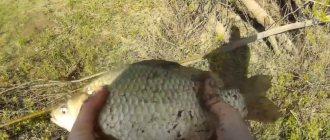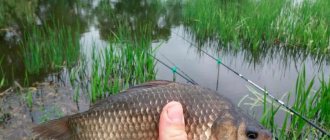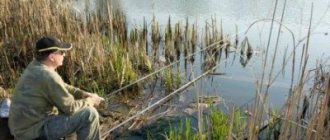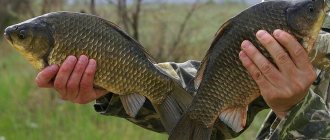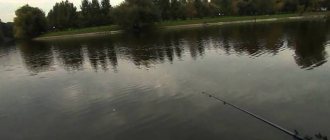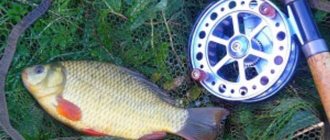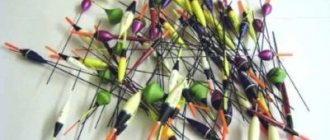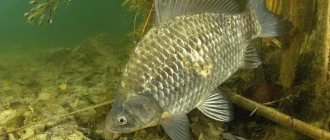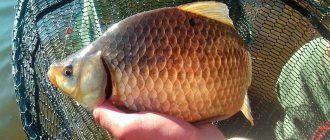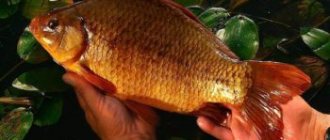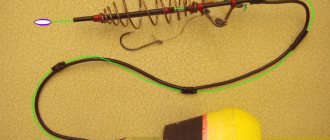It’s an early summer morning, fog is spreading over the surface of the lake water, we are already on the lake, getting ready for the morning crucian fishing from a boat. We will use the most ordinary float rod to catch crucian carp from a boat. In the center of the lake it is deeper and we are going to catch the largest crucian carp in the depths of this lake. We will catch crucian carp using baits such as a regular earthworm, and we have also prepared semolina porridge for catching crucian carp. Crucian carp is very fond of various fragrant baits, so when preparing bait for catching crucian carp, this point must be taken into account.
Crucian carp is also caught very well using baits such as a bunch of bloodworms, maggots, but still, if a fish such as rotan or ruffe lives in a reservoir next to the crucian carp, in order to avoid the attack of the bait proposed for crucian carp by these weed fish, it is better when fishing for crucian carp use animal baits, for example, dough or porridge. Today we will also feed the crucian carp, because large crucian carp should be suitable for bait. Usually, it is not the large crucian carp that approaches the bait at first, and then the larger representatives of the crucian family. The weather today is not at all bad and we, of course, are counting on a good bite of crucian carp today. Although crucian carp can be a very whimsical fish, we think today it will be very active.
When fishing for crucian carp with a float rod, it is best to plan so that the nozzle intended for catching crucian carp is either at the very bottom or above the very bottom during the fishing process. This is understandable, because crucian carp is a bottom-dwelling fish that prefers to look for food by digging into the mud at the very bottom. Of course, there are cases when crucian carp is caught in half the water and almost at the very surface, but such cases of catching crucian carp are quite rare. Today we didn’t experiment and resorted to the classic version of catching crucian carp with a float rod from the bottom. Today we are catching crucian carp from a boat together, in order to understand what crucian carp prefers to be caught with today, we use various baits.
Catching lake crucian carp with a fishing rod from a boat - Video
The depth below us is about three meters, but it is precisely at this depth that large crucian carp stay. We fed the place very well; for bait we used groundbait that we bought at the store. We moistened the bait called crucian carp with water, rolled it into balls and threw it not far from the place where we caught crucian carp on a fishing rod with a float. As we were advised in the store, this bait is the best for catching crucian carp, so we decided to try it. In general, it is best to always add some additional flavoring to crucian bait, so the bait for catching crucian carp will work more effectively, which will have a positive effect on the catches of crucian carp...
bolshayaribalka.ru
Pond crucian carp never ceases to amaze, and the fishing scales are always swinging, on one side of which there is “no bite at all”, on the second - “how to catch in order to catch”...
Usually, the best time to catch large crucian carp is in the spring; at other times of the year, they are a rare visitor to the coastline. Often this sly guy has another constant, unique feature that not everyone knows - he prefers a moving nozzle. Those anglers who have figured this out have more consistent catches. During the “spring ban” when fishing from the shore, I try to choose a place so that the wind is from the side so that the float moves, and it doesn’t matter which direction it blows, it usually doesn’t affect the bite, the main thing is that it helps me with the placement of the equipment .
In the summer, I prefer to catch crucian carp from a boat, since coastal fishing ceases to be effective. The boat allows you to anchor on guy ropes with two weights in any place you like in a comfortable wind position. I use two fly rods. I use light equipment, the load capacity of the float is no more than one gram, only in strong winds can I increase it to two grams. It’s better, of course, when there is practically no wind, and there is simply some traction along the water surface, which slowly, due to the fishing line loop, pulls the nozzle along the bottom.
It turns out to be a kind of wiring, but this is ideal. Although everything goes well even with a well-felt wind, however, the ripples on the water somewhat interfere with observing the floats, when the bites are very careful, you won’t notice it right away. But as soon as there is complete calm, and the bite cuts off, you may not see a bite at all, leaving the bait motionless. In this case, every half a minute I begin to slowly pull the float towards me by 5-10 cm, the nozzle begins to move along the bottom, and if the crucian carp is nearby, the bite follows immediately.
I consider it very important to pay attention to setting the precise working descent of the float tackle.
The bottom of the ponds is varied: there are places with pure silt, and there are places overgrown with a grass carpet. On a clean bottom, I set the depth so that the sinker just barely touches the bottom, but does not lie on it. Then the wiring turns out to be slow. When the wind increases, the wiring also speeds up. In this case, the crucian carp also takes well, but the number of idle hooks increases - apparently, the fish does not have time to properly grab the bait. In places with an overgrown bottom, I set the depth so that the sinker is in the water column, and the hook with the nozzle strikes along the surface of the grass carpet.
I usually fish with pearl barley. Other nozzles are more attractive to small things, and rotan may not allow you to breathe. I consider feeding pond crucian carp generously when float fishing a futile task. I usually stand in place and, if there are bites, I periodically throw a dozen or two pearl barley grains to the floats, which allows me to hold off the flock for a while. If it gets caught, gets scared, or leaves on its own, then after a while the next active flock will become interested in the white grains at the bottom.
But there are times when the crucian carp becomes a stake and stops all movement. There is no point in hatching such fish, so I switch to exploratory fishing. In some ways, this is reminiscent of searching for active fish in winter, only now the search is done from a boat and crucian carp are being looked for. Moving on a boat along the pond, I anchor in the places I like, but only with one anchor, and check the point with fan casts. I use only one fishing rod when searching. One anchor and one fishing rod are for mobility. After casting, I don’t keep the equipment in one place for more than two or three minutes.
If there is no bite, then I re-cast half a meter to the left or right. Whenever you get a crucian carp under your nose, the bite happens almost immediately. Very often the fish grabs the bait immediately after casting, when it has not yet reached the bottom.
When exploratory fishing in one place, as a rule, no more than one or two marketable specimens are caught, and then I move on. Small fish up to 2/3 of the palm of your hand are often found in schools of up to a dozen individuals, and if you run into such a school, they will bite constantly, but a solid crucian carp mixed with small fish will not bite. However, if it just stops pecking on small things at the point, this means that the school has either been caught, or marketable crucian carp has arrived. So it’s promising to make a few more casts, and if the freight train approaches, it will definitely bite. But no, so I move on to the search.
Having figured out that the secret of catching crucian carp is in a moving bait, even on the most unfavorable days for biting I am able to catch a catch. And I often watch how fishermen, ignorant of this crucian carp problem, sit and sadly look for hours at heavy floats with bait firmly anchored at the bottom. I try to suggest what can be done, but some people just brush it off. Maybe they will at least hear the advice via the Internet?
lovimvse.ru
Crucian carp is found almost everywhere, so there is no need to look for its habitat. Usually crucian carp are caught in a river or lake, as well as in small bays where reeds grow. Crucian carp is a small fish that is very mobile. One school of crucian carp can consist of several dozen fish.
If you catch several fish in a row while fishing, this means that you can count on a good catch today. To catch large fish you need to have endurance and patience. Also, a lot depends on the bait.
To catch crucian carp from a boat, you need to purchase a small fishing rod. You also need to take several types of bait with you; it must be dry, after which it is prepared on the spot and thrown to the fishing point. In this way, each angler will be able to keep the fish in a certain place for several tens of minutes after each feeding. When fishing, the float should be in a vertical position, and its lower part should be slightly submerged in water. It is necessary to properly clamp the weight on the fishing line so that it is above the leash.
The rod should be stiff and have a thick line on it, this will allow you to pull out large fish. If during fishing the float sinks and smoothly begins to move to the side, it means that the bite has begun, at this moment it is necessary to hook the fish. The hook must be careful, and the rod must also be carefully lifted up.
Large crucian carp can be found near the shore, especially in the place where reeds grow. Many anglers feed this area within a few hours and thus improve the bite for the whole day. Crucian carp love to be in vegetation, as there is a lot of food in it, and it is also an excellent refuge from predatory fish. Along with crucian carp in the reservoir there may be perch and pike, which are not averse to eating small crucian carp.
If there is a small inlet in the reservoir where the water is cold, then this is an excellent place for crucian carp, especially if it is also deep. Crucian carp is caught almost until winter and after the frost itself, when spring comes. Therefore, crucian carp is not caught for almost several months a year; the rest of the time it is excellently caught and pleases many anglers.
www.ribalka.su
Choosing a boat.
The best solution is of course an inflatable boat. Fishermen living near reservoirs can still see wooden or duralumin boats standing near the shore. The visiting fishermen now only have inflatable boats. In my opinion, the best option is a two-seater inflatable boat with a hard floor, the side height is at least forty cm. On a two-seater boat you can fish completely, it’s a paradise for one. A hard floor makes it much easier to stay on the water for a long time; you can stand up calmly and move around the boat easier. It is advisable to have two anchors; in windy conditions this helps to set up the boat as needed by the fisherman.
Tackle for fishing from a boat.
When fishing from a boat, I fish with an ordinary float rod. Depending on the fishing location, I put a hook or a jig, I use sliding or “dead” floats - it all depends on the casting distance. I store hooks and jigs with leashes on the leash, I knit them in advance. I connect the leashes to the main line using the loop-to-loop method. My jigs are matched to certain floats and if the weight of the jig is small, I add more weight to them. When fishing with a hook, I use two or three sinkers, distributing them from the float to the hook. You always have with you a five-meter fishing rod with a nod specifically for the jig, and in most cases it is much more effective than a float fishing rod. When fishing from a boat, I fish with two float rods or one with a nod. Fishing with more than two float rods will only create problems for yourself, and with a good bite, only one rod. Otherwise, everything is the same as when fishing from the shore at certain times of the year. Good luck with your fishing!
A little humor.
sekretuspeh.ru
Equipment of a float rod for crucian carp
The equipment depends on how you plan to catch crucian carp:
- Main line:
- Swing or plug fishing – diameter up to 0.16 mm.
- Match or Bolognese fishing - diameter up to 0.25 mm.
- Float load capacity
up to 1 gram: - When fishing in still water, use a short keel.
- When fishing in the current - with a long keel.
- Sinker pellet
. One pellet if a quick immersion of the bait is required and several pellets if the crucian carp is in the water column and not at the bottom.
A fluorocarbon leash- Hook
No. 8..No. 12 according to the European classification. The size and color of the hook must match the nature of the bait.
Correct and sensitive float loading
To catch crucian carp you need a fairly sensitive float. Loading is carried out at the base of the antenna so that the body of the float is in the water. This will allow you to record the most subtle types of bites.
The float for a match fishing rod is loaded even more, leaving on the surface only a thickening located at the top of the antenna.
Effective float fishing technique
The fishing technique is chosen depending on the nature of the reservoir. If this is a pond without a current, then here you need to throw the tackle into the water and wait for a bite.
When fishing in a current, the task becomes more complicated. Several techniques can be used here. The first option is to fish for crucian carp using wire. To do this, you need to set a certain depth and throw the tackle into the water. Under the influence of the current, the bait will move in the water column at a certain depth.
When fishing in a weak current, holding a line may be more effective, just like when fishing for roach.
Fishing for crucian carp: do you need a boat?
Most fishermen, when going to catch crucian carp, do not take a boat with them. They believe that a good bite can be achieved by fishing from the shore. Unfortunately, this is not always the case. On many reservoirs, a swimming device helps to occupy a more advantageous place, where crucian carp bite more actively, and various negative factors (noise of vacationers and other fishermen on the shore, high water temperature in the coastal part, etc.) have less influence on the bite. In addition, on some lakes and ponds you can only catch this fish from a boat.
For example, these are reservoirs where, at a distance of 8-10 m from the shore, the depth is less than 1 m. Naturally, in the heat, trying to catch crucian carp here with a float rod is pointless. It is not always possible to use long-casting gear. Still, crucian carp are mainly caught in small bodies of water with dense vegetation, in swampy ponds, peat bogs, etc. Not to mention the fact that the most promising places for fishing are most often significantly removed from the shore and the swimming device turns out to be very useful.
Catching crucian carp from a boat has another advantage. This is an opportunity to camouflage yourself among the coastal thickets or, conversely, fish in the depths without scaring away the fish with long casts. Finally, the most important thing is that a fisherman on a boat has a much better chance of catching large, and perhaps even trophy, crucian carp, which always lives at a distance from the shore.
Features of rod selection
There are 3 types of float rods for this type of fishing. These varieties differ in the characteristics of the equipment and the rods used.
The Bologna type fishing rod has a telescopic device, rings and a holder for a spinning reel. The most suitable length of a Bolognese type rod is 4-6 m. Such a rod helps to cast over an impressive distance and catch crucian carp in places located at a distance of 20-30 m from the coastline.
A match fishing rod, like a Bolognese fishing rod, helps deliver bait to a place quite far from the coastline. The optimal length of such a fishing rod is 3.5-4.5 m. But since it is quite difficult to accurately cast with a rod of this type, anglers rarely use it for such fishing.
In addition to the rod, equipment for catching crucian carp with a float rod also includes the following elements:
hooks – not very large, the choice depends on the bait used;
float - must have a high degree of sensitivity and carrying capacity necessary to cast the bait to the desired distance and keep it in the required fishing horizon;
connector - attached to the tip of the thinnest last knee;
lead pellets for correct loading of the float;
main line - suitable diameter for the main cord: 0.12-0.14 m (braided line is not a suitable option in this case);
a leash 10-20 cm long from a thinner fishing line (suitable fishing line diameter for a leash: 0.08-0.10 m).
We remind you that crucian carp is a special fish in terms of caution and choice of “dishes”. Most fishermen are aware of its vagaries in the choice of smells, bait, as well as bait and attachments. The feeding preferences of crucian carp change almost every day. While fishing you may encounter this phenomenon. In the morning he pecks at the worm, and in the evening give him only maggots. Therefore, when choosing bait, always focus on several options, even if you are going to one body of water.
Places for catching crucian carp from a boat
Arriving at a pond, every angler is puzzled by the question of where is the best place to fish from a boat. At any time of the year and regardless of weather conditions, there are places that are more preferable for fish. These are the so-called “paths”. Along them, a conditional school of crucian carp moves to areas where it feeds, or where it waits out bad weather or until the night ends. Find one of these places and successful fishing is almost guaranteed.
However, finding a current fish site is not an easy task. Depending on the time of year, weather, atmospheric pressure, etc., crucian carp can choose completely different places of deployment. But there are such universal areas of the reservoir where the probability of meeting fish is always quite high. This is where the boat needs to be placed. Typically this is:
- tall aquatic vegetation pushing through the water;
- an island of thickets in the middle of the deep and shallow waters;
- accumulation of snags;
- depth difference or border with the deepest zone in the reservoir;
- backwater or branch from the main channel;
- thickets of reeds, etc.
How to recognize a crucian bite
Crucian carp bites in its own way. After catching him several times, you will easily begin to distinguish his habits. According to generalized data, the entire process of biting it can be divided into three stages:
Stage #1:
Grade. Crucian carp is a “sniffing” fish. He has a naturally keen sense of smell. Therefore, you can attract him not only with standard, but also with specific smells. For example - kerosene.
[THERE IS AN ANSWER] How to catch roach in the summer using a float rod?
So, the fish sees the bait, comes up and starts “sniffing”. Therefore, at this time it is advisable not to actively loom on the shore and not make noise. By the way, there is a belief that trophy fish, which have extensive experience in “escaping” from the hook, will circle around the bait they like for a very long time and evaluate its smell.
Stage #2:
The crucian carp liked the bait, it's time to try it. If the bait is large, the crucian carp will pinch it off in small portions until there is a piece left on the hook of a size that would easily fit into the fish’s mouth. During this time, the float will shake and rise and fall slightly. We muster our will and wait. You can hook, but it may not bring results. The fact is that all the bait has not even been in the fish’s mouth yet.
Stage #3:
The main thing here is not to oversleep. The crucian carp swallows the rest of the bait, at this time the float makes several rises, after which it can lie on its side or go to the side. It's time to hook!
When using a sports float, pellets spaced along the line work better. Also, the choice of sinker depends on the conditions of the reservoir.
A float fishing rod for crucian carp, the equipment of which does not involve the use of a self-loading float, is equipped with one or more sinkers. They can be pellet or olive shaped.
Depending on the type of equipment, one or another form is used; you can often see a combination of pellets and olives.
When using a sports float, pellets spaced along the line work better. Also, the choice of sinker depends on the conditions of the reservoir.
The choice of fishing location is also important. Most often, crucian carp are found near snags, grass, and tree branches, especially in hot weather. You must be quiet and careful. It is better for the fisherman to be in the shade so as not to be visible to the fish. Be patient and you will succeed.
Bait for crucian carp
Currently, there are many baits for this fish, but they will not give you instant results. It is important to feed the fishing area in advance. Moreover, river crucian carp is more susceptible to bait than pond carp. It is also important to know that fish feed mainly at the bottom, so it is important to add silt or earthen mixture to the bait.
The choice of fishing location is also important. Most often, crucian carp are found near snags, grass, and tree branches, especially in hot weather. You must be quiet and careful. It is better for the fisherman to be in the shade so as not to be visible to the fish. Be patient and you will succeed.
Of course, in order to understand all the intricacies of crucian carp fishing, you need to go fishing and try everything in practice, since some tips, when approaching one body of water, do not apply to another. And maybe luck will smile on you. And no one will ever forget the taste of fried crucian carp or in sour cream.
There are two types of float rods:
Tackle for catching crucian carp from a boat
A float rod is the main equipment for catching crucian carp from a boat. Some fishermen use donks and even winter “balaykas”, attracting fish with the play of a jig with a miniature nozzle. But these are all isolated cases. Therefore, the focus of our attention is a fishing rod with a float.
When choosing tackle for boat fishing, first of all pay attention to the size of the rod.
There is no point in using long fishing rods. They will only get in the way. Such gear does not allow you to accurately cast the rig, especially from a sitting position. It turns out that when you are fishing on a boat in the bushes, you can easily get caught on some branch or snag due to improper casting. Another argument against long fishing rods is the need for heavy equipment, which can be noticed by the fish.
Therefore, choose light rods. The optimal length is 2-5 m. It is best to fish from a boat using a telescopic rod with a reel and rings. This type of equipment is distinguished by its reliability and mobility. It can be quickly adapted to a wide variety of fishing conditions.
Now let's talk about equipment. On a float rod with which you plan to catch crucian carp from a boat, it is best to use a fishing line with a thickness of 0.16-0.2 mm. Leashes that are thinner than the main line are also required - 0.14-0.18 mm. Often fishing from a boat takes place in bushes or reeds, where there is a risk of getting caught on algae or grass. It would be less offensive to tear off the leash than to lose all the equipment with a float.
A large number of weights are not required. After all, it is best to fish from a boat with tackle with a light float - from 1 to 2 g. There are no special requirements for hooks. The main thing is that their size matches the crucian carp living in the reservoir. If you find mostly fish weighing more than 300 grams, then hooks No. 10-12 are suitable. For catching small crucian carp – No. 12-14.
Techniques for catching crucian carp
- In order to catch a crucian carp, it will be enough to wait until the moment when the float sinks or lies on the water.
- After each cast, it is recommended to feed the area with a small amount of bait. This will help increase your chances of getting a bite. When the float assumes a vertical position, periodically you need to smoothly tighten the fishing line.
- If a bite is visible, then you need to hook sharply. If the force is too strong, then it is not recommended to pull the crucian carp to the shore. Use a landing net.
Best time to go fishing from a boat
You can use the boat for crucian carp fishing for almost the entire open water season. But there are periods when boat fishing is more or less effective. Let's start with spring. At this time, the awakened crucian carp strives for shallow water, where it can not only bask in warmer water, but also find food for itself. Then the fish begins to spawn, and it also lives near the shore. Therefore, spring fishing from a boat is not in great demand.
In June and July the situation changes. Catching crucian carp from a boat often gives good results. The fact is that in the coastal part there is less oxygen and the fish go deeper. Of course, you can successfully fish from the shore using long-distance casting gear. But it’s easier to feed crucian carp from a boat and there is always the opportunity to fish in small creeks, swampy areas or places covered with dense vegetation.
At the end of summer and autumn, a boat is indispensable when catching large crucian carp.
If in June and July it still often feeds near the shore, then from the end of August you have to look for it in holes and dumps, in snags and reeds. Naturally, you can’t do without a boat. In addition, in many reservoirs, predatory fish become active at this time, and crucian carp hides in places where it is simply impossible to catch it without a watercraft.
Choosing a fishing spot
Fishing for crucian carp with a float can be done both from the shore and from a boat. The boat is used if the angler cannot gain access to the crucian carp habitat. Most often this happens in overgrown reservoirs, where there are a lot of fish, but there are practically no open places for fishing.
[THERE IS AN ANSWER] Which floats are best to use for catching crucian carp
It is also worth noting the places where the likelihood of meeting crucian carp is highest. They are:
- Thickets of cattails and reeds,
- Places under overhanging trees,
- Near hydraulic structures,
- Near boulders and huge stones sticking out of the water,
- Brovki.
Some experienced fishermen, in order to increase the number of crucian carp in the fishing area, specially place large stones and other objects under the water.
float - must have a high degree of sensitivity and carrying capacity necessary to cast the bait to the desired distance and keep it in the required fishing horizon;
